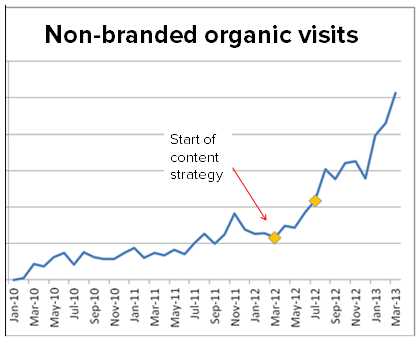What happens when the majority of your website traffic uses branded keywords to get to your site? At first, you might be pleased to know that people know of your brand and convert shortly after visiting your website, but what about new visitors? Brafton has reported that Google’s Avinash Kaushik finds that most companies view brand queries as the keys to their search conversions, but actually half of visitors who land on sites through generic terms convert – just not on their first visits.
Don’t you want to attract new audiences to build your customer portfolio and bolster your bottom line? Many companies experience this problem when implementing internet marketing campaigns. They want to broaden their reach with custom content, but their articles are going widely overlooked by web searchers who are unaware of their brands, products and services.
Ranking No. 1 on Page 1 of Google SERPs for branded key terms doesn’t mean anything unless web traffic already knows about the brand and what it has to offer.
Ranking No. 1 on Page 1 of Google SERPs for branded key terms doesn’t mean anything unless web traffic already knows about the brand and what it has to offer. When it comes to organic search discovery, companies must leverage semantic key phrases to draw in new audiences and use content to educate and inform consumers. Branded content can help companies carve out their niches in crowded industries, as long as they convey their core values to new visitors through organic keywords that reach wandering web searchers. If people don’t know what you do and what your products can help them solve, you aren’t using your content marketing budget effectively.
Unbranded traffic will clue you in on who your actual and potential customers are, showing you what they search for online. In evaluating your content analytics, you might discover that the traffic your site serves doesn’t convert, isn’t relevant to your offerings and bounces shortly after entering your page, but this information also helps you understand the type of information your visitors do absorb. Do people visit your site and frequently navigate to a specific service page? Maybe a commercial page wins the lion’s share of your organic traffic, and you can uncover a keyword pattern. Take these trends seriously: Optimize your future blog content and landing page copy to mirror the strategy used to craft the popular sections of your web presence. Perhaps your audience isn’t who you thought it was – your core offerings may resonate with people you didn’t even consider before.
Client success: Content strategies require adaptability
 I have a client who faced challenges similar to what I described above. This is a data security vendor, who had an active customer base in the third-party warranty sector, but people didn’t fully understand the service. More, the keyword strategy they developed set them up to compete with major technology and software brands, which put them at a steep disadvantage. My goal was to show them that non-branded keyword traffic would not only help them grow their customer base, but also lead directly to an increase in conversions – or, at least opportunities for sales. After consulting my client through the beginning stages of its content campaign, the site saw steady increases in non-branded keyword traffic. What was the effect of this new audience? They saw nearly a 10-fold increase in new leads per week. Below I outline some strategies used to help my client experience such significant growth through website content.
I have a client who faced challenges similar to what I described above. This is a data security vendor, who had an active customer base in the third-party warranty sector, but people didn’t fully understand the service. More, the keyword strategy they developed set them up to compete with major technology and software brands, which put them at a steep disadvantage. My goal was to show them that non-branded keyword traffic would not only help them grow their customer base, but also lead directly to an increase in conversions – or, at least opportunities for sales. After consulting my client through the beginning stages of its content campaign, the site saw steady increases in non-branded keyword traffic. What was the effect of this new audience? They saw nearly a 10-fold increase in new leads per week. Below I outline some strategies used to help my client experience such significant growth through website content.
Landing pages: They’re launching pads for success
“We’re seeing more views, more opportunities and more deals from unbranded organic traffic.”
My client needed to build out its website. The landing pages it already had on its site spoke to audiences with prior knowledge of the company’s products and services, and alienated anyone who didn’t already opt-into the service. I made sure to enhance my client’s website with landing pages that broader industry trends as they related to services offered. I also set up category landing pages for all of the company’s ongoing articles, so viewers can access related content from one place. These news category pages had the side effect of building naturally keyword rich pages, filled with useful and timely content around key phrases. Because the company operated within a third-party warranty sector it had an opportunity to talk to audiences with tech issues – their manufacturing warranties had expired, but they still needed help. We made sure we offered the right advice through related headlines, and included CTAs that least pointed these web searchers toward my client’s L3 technicians for assistance.
Keywords: Don’t focus solely on branded phrases
You can’t see the forest through the trees if you focus only branded terms because they get the most conversions. While you want to be the first site that shows up for your company’s names in Google SERPs, you also want to be present for other queries. By optimizing your web or news content with semantic or other targeted phrases, you reach prospects who happen upon your writing, and your site organically builds PageRank the more you build credibility for certain subjects. Don’t be afraid to diversify your keyword strategy – look at your site’s free Google analytics and Webmaster tools to learn if people are reaching your page from specific terms unrelated to your business’ name. This is a great jumping off point for your content plan, and as you evaluate your incoming traffic, you can consistently update your site with content that uses a wide range of traffic-generating phrases.
Also, use social listening and customer conversations to drive keyword ideas. Do fans or followers use unexpected language to explain your products or services?
Content types: Diversify your website
 Let’s face it: Not everyone searches for the same content type on the web. I might like written content, but my colleague could prefers something video or visual media. The more diverse your content offering becomes, the greater your odds of breaking into new markets. For example, if you enhance your web presence by producing infographics, your customers may share your media via their social platforms, allowing you to appeal to their personal networks. You can also show up in Image Searches to reach new users looking for visuals. When you produce video content for YouTube, your brand appears in in SERPs and reaches active video-sharing consumers. Optimize both your infographics and video content with supplementary blog posts or meta descriptions to add SEO value and drive organic traffic back to your website.
Let’s face it: Not everyone searches for the same content type on the web. I might like written content, but my colleague could prefers something video or visual media. The more diverse your content offering becomes, the greater your odds of breaking into new markets. For example, if you enhance your web presence by producing infographics, your customers may share your media via their social platforms, allowing you to appeal to their personal networks. You can also show up in Image Searches to reach new users looking for visuals. When you produce video content for YouTube, your brand appears in in SERPs and reaches active video-sharing consumers. Optimize both your infographics and video content with supplementary blog posts or meta descriptions to add SEO value and drive organic traffic back to your website.
Go forth, and unbrand your website for a moment
As a marketer, it’s hard to not think about your brand all of the time, but sometimes it helps your business grow. Look at your navigation summaries to see where your non-branded traffic comes from and goes to on your site, and beginning building content to appeal to those consumers. You might find that with a few tweaks to your keyword strategy that a whole new world of customers lies just beyond the search engines, looking for you and what you have to offer.



